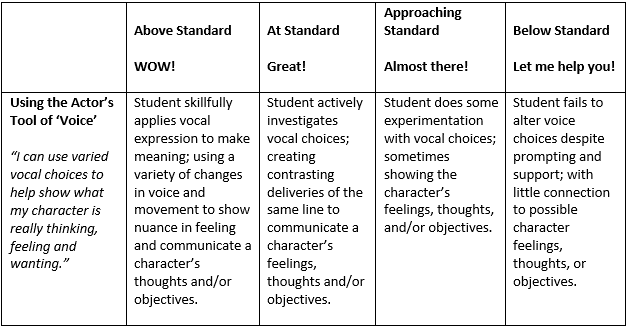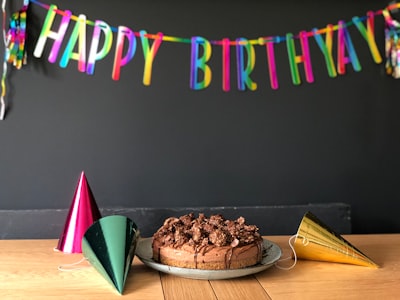
Click to Teach/Click to Learn: Show What You Want
In this unit of instruction, students will experiment with vocal choices to understand how actors use their voice to convey meaning and show what a character wants.
This unit is best suited for elementary students in Grades K-3, but can be adapted to other elementary grades.
Learning Outcomes:
- The learner will explore warming up their actor's tools.
- The learner will make meaning with vocal expression by saying a line different ways.
- The learner will experiment with pursuing a character's goal using various tactics.
Step 1: Get Inspired
A. WATCH
In the movie "Peter Pan & Wendy" a girl named Wendy and her brothers adventure to Neverland with Peter Pan and Tinkerbell. Watch this video to see what happens when Wendy and her brothers meet Tinkerbell and Peter Pan for the first time.
B. LISTEN TO YOUR TEACHER
Teacher:
Actors don't tell a story, they show a story. Actors have three tools that they use when they are showing a story: their voices, bodies, and imaginations.
In the movie clip, we saw the actors that play Wendy and her brothers use their Actor's Tools. They used their imagination to pretend they were looking at a fairy. They used their bodies to show what it would look like to wake up with a fairy in their room. They used their voices to show what it would sound like to wake up and see Wendy flying and see Tinkerbell in their room.
Step 2: Warm Up
A. LISTEN and COPY
Teacher:
In this lesson, we will start with a warm up of all of the things in our Actor's Toolbox - our voice, our body, and our imagination.
Find a space where you have plenty of room and you aren't touching anyone or anything, and make sure you can still hear and see your computer screen. Follow me and let's do a warm up together!
Note to Teacher: Lead your class in a warm up, or use the video below to guide your students through a warm up.
If you want to practice warming up your actors tools on your own, you can play this video and follow along to warm up your actor's tools at home.
B. LISTEN and SHOW
Teacher:
It is time to use your actor’s tools to help to show Wendy's story.
How would you feel if you woke up with a fairy in your bedroom? Pretend with me right now that you were sleeping and you woke up to find a small fairy was making you fly. Then you see the fairy for the first time. Use your actor’s tool called imagination, but don’t use your voice or body yet.
Now, let’s use our imaginations and our bodies to show that same story - no voices yet. Ready? Imagine you are seeing the fairy Tinkerbell for the first time, and show me what your body does.
Now, we are going to add our voices. Imagine you are seeing the fairy Tinkerbell for the first time, and show me what your voice and body do. Ready, go!
Step 3: Vocal Expression
A. LISTEN and DO
Teacher:
Our voices can show what we're thinking or feeling. It's not what you say - it's how you say it.
Imagine these two stories:
- Sasha was helping her grandmother carry her groceries inside when she accidentally dropped the eggs, and they cracked all over the floor. She looked at her grandma and she says "I'm sorry...". How do you think she said "I'm sorry"?
- Isabella and her brother were playing a game. Her brother lost the game, and he got angry and decided he wanted to get Isabella in trouble. He called to his mom and told her that Isabella cheated at the game they played, even though she didn't. Isabella's mother told Isabella that she had to apologize to her brother. How do you think she said "I'm sorry"?
Have you ever had to say you're sorry when you really don't mean it? In the second story, Isabella probably didn't really feel sorry, because she didn't really do anything wrong. That apology probably sounded very different than the first story when Sasha broke the eggs. Our voices show what we're thinking or feeling.
Actors can do a lot with our voices. We are going to experiment with using our voices, like actors do, to show what characters are thinking, feeling, and wanting. We are going to learn to say the same thing in different ways to show different meanings. Ready? Say you're sorry as if you were Sasha after she accidentally dropped the eggs. Ready, set, go! Now, say you're sorry as if you were Isabella when she had to apologize to her brother. Ready, set, go!
B. WATCH
Watch this video to see some examples of actors using their voice to show what they are thinking or feeling.
Reflection: What were some of the ways these actors used their Actor's Tools of voice, body, and imagination to show you what they were thinking and feeling?
C. DO
Note to teacher: You may use this as a student self-directed activity or as a group activity during class.
ACTIVITY: Now it's your turn to practice. You are going to say "I'm never going back to school" in 3 different ways.
Think about all the different ways you can say it. What are all of the different feelings you can show? Here are some ideas:
- Excited
- Sad
- Angry
- Hopeful
- Surprised
- Make up your own!
Even though you are saying the same words all 3 times, your performances should sound different. Remember: It's not what you say, but how you say it.
Step 4: One Word Play
A. LISTEN and SHARE
Note to teacher: This acting exercise called “One Word Play” is designed to teach children the ways in which a character pursues a goal using various tactics. It may be helpful to ask the children to think of a time when they tried to get their parent or guardian to do or give them something they wanted, and the parent or guardian repeatedly said no. Children will instinctively give this scene a clear beginning, middle and end, but you may also help this process by finding a natural ending yourself as the “parent” in the scene. When you have finished demonstrating with a volunteer, give the children time to reflect on the different tactics the “child” tried to get what they wanted. Then pair up the children and ask them to create their own one word play following the example you modeled in class. The final step will be to ask the children to choose a variation on the one word play to create and submit their own one word play as homework.
Teacher:
Now we will be using our Actor's Tools of voice, body, and imagination to act out a play with a partner. In our play there are two characters - a child and a parent. Each partner will be a character; either the child or the parent. The tricky part is that in this play each character only gets to say one word. Your character can say that one word in many different ways to try to get your partner to give you what you want.
I will be here to help you make sure your play has a clear beginning, middle, and end.
Note to teacher: Model this activity in class first.
Let me show you what I mean. Can I have a volunteer? Great!
Story: Let’s pretend that you are a four year old child and I am your parent and we are at the store. We just passed the candy aisle and you asked me for a big giant candy bar and I told you no because it was almost time for lunch. You start by saying “why?” and I will say “because”. You may say “why” as many times as you want to try to get what you want, but you can only say “why”. And I can only say “because”. Ready?
Note to teacher: After you've modeled the activity with a volunteer, lead the class in a discussion about what they just saw. Ask guiding questions such as...
Reflection:
- What did each character want in the scene?
- How did they use their voices to try to get what they wanted?
B. DO
Note to teacher: Students will now create a one word play with a partner. If you're in a classroom setting, you can pair students up with each other. If you're in a virtual classroom setting, you can pair students up in breakout rooms. If you choose to assign this as homework for students, encourage students to find a family member or a friend to be their partner, or students can record themselves playing both characters. You may ask students to record their scene and submit it as their final project.
ACTIVITY: Now you are going to create your own one word play!
You and your partner are going to play two characters - a parent and a child.
Step 1 - Pick Lines: You and your partner need one line to say. You can use the lines "Why?" and "Because" from the example, or you can visit this page created by CreativeDrama for 6 other options.
Step 2 - What does your character want?: Next, you and your partner should decide on what each of your characters want. This will help you show the story with your voice.
Step 3 - Practice your Scene: With your partner, practice and share your own One Word Play. Remember that each partner is only allowed to say their one line that they chose. You can say this one word as many times as you want to give the story a beginning, middle and end.
KEEP IN MIND - Even though you will be repeating the same words over and over, it should sound different each time. Remember, it's not what you say, but how you say it. Use your voice to show what your character is thinking, feeling and wanting.
Measuring Learning

Classroom Connections
This lesson is best suited for elementary Grades K-3, but can be adapted for other grades.
Grade K - TH:Pr6.1.K.a. With prompting and support, use voice and sound in dramatic play or a guided drama experience.
Grade 1 - TH:Pr4.1.1.b. Use body, face, gestures and voice to communicate character traits and emotions in a guided drama experience.
Grade 2 - TH:Pr4.1.2.b. Alter voice and body to expand and articulate nuances of a character in a guided drama experience.
Grade 3 - TH:Pr4.1.3.b. Investigate how movement and voice are incorporated into drama/theatre work.
Diving Deeper
A. READ
Read this poem entitled "Happy Birthday" by Shel Silverstein.
So what if nobody came?
I'll have all the ice cream and tea,
And I'll laugh with myself,
And I'll dance with myself,
And I'll sing, "Happy Birthday to me!"
Credit: Shel Silverstein's Poems Live On In 'Every Thing' (NPR)

B. DO
If you want to dive deeper, you can record yourself reading the poem "Happy Birthday" by Shel Silverstein twice. Choose a different meaning for each of your two performances.
First, decide what the story is about. What do you think this character feeling? What do you think this character wants? Write down at least 3 ideas of what the character could be thinking or feeling.
Choose one of the emotions from your list. For your first time reading through the poem, focus on using your voice to show that emotion. Then, choose a different emotion for your second time reading through the poem. Again, focus on using your voice to show that second emotion.
Create a video or audio recording of yourself showing your two readings of the poem "Happy Birthday" by Shel Silverstein. Each reading should show a different feeling.
| Access Date | Quiz Result | Score | Actions |
|---|
Learning Center
- Webinars
- Adjudication Trainings
- Featured Courses
- Full Course List
- Lesson Plan Library
- Click to Teach Interactive Online Lessons
- Resources for New Theatre Teachers
- Technical Theatre Educator's Manual
- Connected Arts Networks
- Diverse Resources for Theatre Education
- Behind the Scenes Technical Theatre Curriculum
- Social & Emotional Learning
- Additional Standards Based Instructional Resources
- Search the Catalog
- Cart (0 items)
Full Site Search
Membership Benefits
Join EdTA for full access to our professional development and standards-based teaching resources, including:
- 300+ lesson plans
- Click to Teach online lessons
- K-12 curriculum
- Webinars
- And more!




